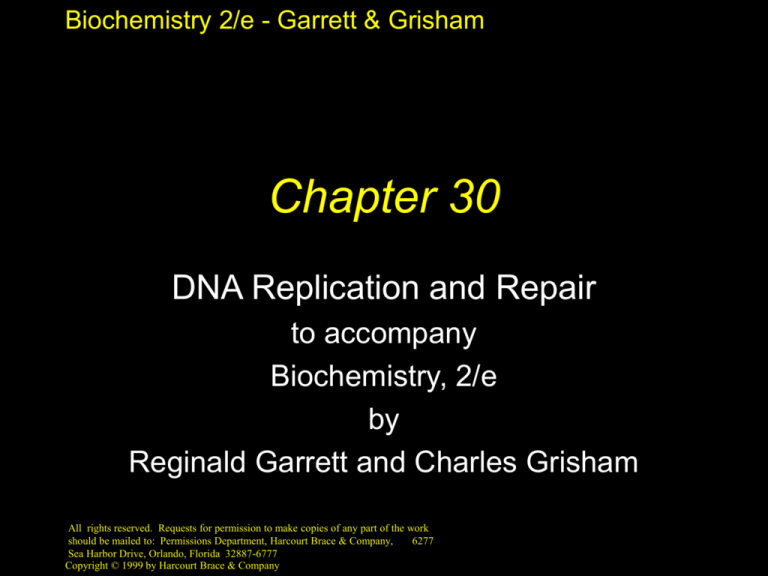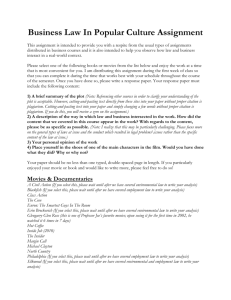
Biochemistry 2/e - Garrett & Grisham
Chapter 30
DNA Replication and Repair
to accompany
Biochemistry, 2/e
by
Reginald Garrett and Charles Grisham
All rights reserved. Requests for permission to make copies of any part of the work
should be mailed to: Permissions Department, Harcourt Brace & Company,
6277
Sea Harbor Drive, Orlando, Florida 32887-6777
Copyright © 1999 by Harcourt Brace & Company
Biochemistry 2/e - Garrett & Grisham
Outline
• 30.1 DNA Replication is Semiconservative
• 30.2 General Features of DNA Replication
• 30.3 DNA Polymerases
• 30.4 The Mechanism of DNA Replication
• 30.5 Eukaryotic DNA Replication
• 30.6 Telomeres and Telemerases
• 30.7 Reverse Transcriptase
• 30.8 DNA Repair
Copyright © 1999 by Harcourt Brace & Company
Biochemistry 2/e - Garrett & Grisham
The Dawn of Molecular
Biology
April 25, 1953
• Watson and Crick: "It has not escaped our
notice that the specific (base) pairing we have
postulated immediately suggests a possible
copying mechanism for the genetic material."
• The mechanism: Strand separation, followed by
copying of each strand.
• Each separated strand acts as a template for the
synthesis of a new complementary strand.
Copyright © 1999 by Harcourt Brace & Company
Biochemistry 2/e - Garrett & Grisham
Copyright © 1999 by Harcourt Brace & Company
Biochemistry 2/e - Garrett & Grisham
DNA Replication
The Semiconservative Model
• Matthew Meselson and Franklin Stahl showed
that DNA replication results in new DNA duplex
molecules in which one strand is from the parent
duplex and the other is completely new
• Study Figure 30.4 and understand the density
profiles from ultracentrifugation experiments
• Imagine and predict the density profiles that the
conservative and dispersive models would show
Copyright © 1999 by Harcourt Brace & Company
Biochemistry 2/e - Garrett & Grisham
Copyright © 1999 by Harcourt Brace & Company
Biochemistry 2/e - Garrett & Grisham
Copyright © 1999 by Harcourt Brace & Company
Biochemistry 2/e - Garrett & Grisham
Features of DNA Replication
• DNA replication is bidirectional
– Bidirectional replication involves two
replication forks, which move in opposite
directions
• DNA replication is semidiscontinuous
– The leading strand copies continuously
– The lagging strand copies in segments
(Okazaki fragments) which must be joined
Copyright © 1999 by Harcourt Brace & Company
Biochemistry 2/e - Garrett & Grisham
Copyright © 1999 by Harcourt Brace & Company
Biochemistry 2/e - Garrett & Grisham
Copyright © 1999 by Harcourt Brace & Company
Biochemistry 2/e - Garrett & Grisham
The Enzymology
of DNA Replication
• If Watson and Crick were right, then there
should be an enzyme that makes DNA copies
from a DNA template
• In 1957, Arthur Kornberg and colleagues
demonstrated the existence of a DNA
polymerase - DNA polymerase I
• Pol I needs all four deoxynucleotides, a template
and a primer - a ss-DNA (with a free 3'-OH) that
pairs with the template to form a short doublestranded region
Copyright © 1999 by Harcourt Brace & Company
Biochemistry 2/e - Garrett & Grisham
DNA Polymerase I
•
•
•
•
•
Replication occurs 5' to 3'
Nucleotides are added at the 3'-end of the
strand
Pol I catalyzes about 20 cycles of polymerization
before the new strand dissociates from template
20 cycles constitutes moderate "processivity"
Pol I from E. coli is 928 aa (109 kD) monomer
In addition to 5'-3' polymerase, it also has 3'-5'
exonuclease and 5'-3' exonuclease activities
Copyright © 1999 by Harcourt Brace & Company
Biochemistry 2/e - Garrett & Grisham
Copyright © 1999 by Harcourt Brace & Company
Biochemistry 2/e - Garrett & Grisham
More on Pol I
Why the exonuclease activity?
• The 3'-5' exonuclease activity serves a
proofreading function! It removes
incorrectly matched bases, so that the
polymerase can try again
• See Figures 30.9 and 30.10! Notice how
the newly-formed strand oscillates
between the polymerase and 3'exonuclease sites,adding a base and then
checking it
Copyright © 1999 by Harcourt Brace & Company
Biochemistry 2/e - Garrett & Grisham
Copyright © 1999 by Harcourt Brace & Company
Biochemistry 2/e - Garrett & Grisham
Copyright © 1999 by Harcourt Brace & Company
Biochemistry 2/e - Garrett & Grisham
Even More on Pol I
Nicks and Klenows....
• 5'-exonuclease activity, working together with
the polymerase, accomplishes "nick translation"
• Hans Klenow used either subtilisin or trypsin to
cleave between residues 323 and 324,
separating 5'-exonuclease (on 1-323) and the
other two activities (on 324-928, the so-called
"Klenow fragment”)
• Tom Steitz has determined the structure of the
Klenow fragment - see Figure 30.9
Copyright © 1999 by Harcourt Brace & Company
Biochemistry 2/e - Garrett & Grisham
Copyright © 1999 by Harcourt Brace & Company
Biochemistry 2/e - Garrett & Grisham
Copyright © 1999 by Harcourt Brace & Company
Biochemistry 2/e - Garrett & Grisham
DNA Polymerase III
•
•
•
•
•
•
The "real" polymerase in E. coli
At least 10 different subunits
"Core" enzyme has three subunits - , , and
Alpha subunit is polymerase
Epsilon subunit is 3'-exonuclease
Theta function is unknown
The beta subunit dimer forms a ring around
DNA
• Enormous processivity - 5 million bases!
Copyright © 1999 by Harcourt Brace & Company
Biochemistry 2/e - Garrett & Grisham
Copyright © 1999 by Harcourt Brace & Company
Biochemistry 2/e - Garrett & Grisham
Features of Replication
•
•
•
•
•
•
Mostly in E. coli, but many features are general
Replication is bidirectional
The double helix must be unwound - by
helicases
Supercoiling must be compensated - by DNA
gyrase
Replication is semidiscontinuous
Leading strand is formed continuously
Lagging strand is formed from Okazaki
fragments - discovered by Tuneko and Reiji "O"
Copyright © 1999 by Harcourt Brace & Company
Biochemistry 2/e - Garrett & Grisham
More Features of Replication
•
•
•
•
•
Read page 994 on chemistry of DNA synthesis
DNA Pol III uses an RNA primer
A special primase forms the required primer
DNA Pol I excises the primer
DNA ligase seals the "nicks" between Okazaki
fragments (See Figure 30.14 for mechanism)
• See Figure 30.15 for a view of replication fork
Copyright © 1999 by Harcourt Brace & Company
Biochemistry 2/e - Garrett & Grisham
Copyright © 1999 by Harcourt Brace & Company
Biochemistry 2/e - Garrett & Grisham
Copyright © 1999 by Harcourt Brace & Company
Biochemistry 2/e - Garrett & Grisham
Mechanism of Replication
in E. coli
• The replisome consists of: DNA-unwinding
proteins, the priming complex (primosome)
and two equivalents of DNA
• polymerase III holoenzyme
• Initiation: DnaA protein binds to repeats in
ori, initiating strand separation and DnaB, a
helicase delivered by DnaC, further
unwinds. Primase then binds and constructs
the RNA primer
Copyright © 1999 by Harcourt Brace & Company
Biochemistry 2/e - Garrett & Grisham
Copyright © 1999 by Harcourt Brace & Company
Biochemistry 2/e - Garrett & Grisham
Replication Mechanism II
Elongation and Termination
• Elongation involves DnaB helicase unwinding,
SSB binding to keep strands separated, and
DNA polymerase grinding away on both strands
• Termination: the "ter" locus, rich in Gs and Ts,
signals the end of replication. A Ter protein is
also involved. Ter protein is a contrahelicase
and prevents unwinding
• Topoisomerase II (DNA gyrase) relieves
supercoiling that remains
Copyright © 1999 by Harcourt Brace & Company
Biochemistry 2/e - Garrett & Grisham
Copyright © 1999 by Harcourt Brace & Company
Biochemistry 2/e - Garrett & Grisham
Copyright © 1999 by Harcourt Brace & Company
Biochemistry 2/e - Garrett & Grisham
Eukaryotic DNA Replication
•
•
•
•
•
Like E. coli, but more complex
Human cell: 6 billion base pairs of DNA to copy
Multiple origins of replication: 1 per 3- 300 kbp
Several known animal DNA polymerases - see
Table 30.4
DNA polymerase alpha - four subunits,
polymerase (processivity = 200) but no 3'exonuclease
DNA polymerase beta - similar to alpha
Copyright © 1999 by Harcourt Brace & Company
Biochemistry 2/e - Garrett & Grisham
Copyright © 1999 by Harcourt Brace & Company
Biochemistry 2/e - Garrett & Grisham
Copyright © 1999 by Harcourt Brace & Company
Biochemistry 2/e - Garrett & Grisham
More Eukaryotic polymerases
• DNA polymerase gamma - DNA-replicating
enzyme of mitochondria
• DNA polymerase delta has a 3'exonuclease as well as proliferating cell
nuclear antigen (PCNA)
• PCNA give delta unlimited processivity and
is homologous with prokaryotic pol III
• DNA polymerase epsilon - highly
processive, but does not have a subunit
like PCNA
Copyright © 1999 by Harcourt Brace & Company
Biochemistry 2/e - Garrett & Grisham
Copyright © 1999 by Harcourt Brace & Company
Biochemistry 2/e - Garrett & Grisham
Copyright © 1999 by Harcourt Brace & Company
Biochemistry 2/e - Garrett & Grisham
Copyright © 1999 by Harcourt Brace & Company
Biochemistry 2/e - Garrett & Grisham
Another Way to Make DNA
RNA-Directed DNA Polymerase
• 1964: Howard Temin notices that DNA
synthesis inhibitors prevent infection of
cells in culture by RNA tumor viruses.
Temin predicts that DNA is an intermediate
in RNA tumor virus replication
• 1970: Temin and David Baltimore
(separately) discover the RNA-directed
DNA polymerase - aka "reverse
trascriptase"
Copyright © 1999 by Harcourt Brace & Company
Biochemistry 2/e - Garrett & Grisham
Reverse Transcriptase
• Primer required, but a strange one - a
tRNA molecule that the virus captures
from the host
• RT transcribes the RNA template into a
complementary DNA (cDNA) to form a
DNA:RNA hybrid
• All RNA tumor viruses contain a reverse
transcriptase
Copyright © 1999 by Harcourt Brace & Company
Biochemistry 2/e - Garrett & Grisham
RT II
• Three enzyme activities
– RNA-directed DNA polymerase
– RNase H activity - degrades RNA in the
DNA:RNA hybrids
– DNA-directed DNA polymerase - which makes
a DNA duplex after RNase H activity destroys
the viral genome
• HIV therapy: AZT (or 3'-azido-2',3'dideoxythymidine) specifically inhibits RT
Copyright © 1999 by Harcourt Brace & Company
Biochemistry 2/e - Garrett & Grisham
Copyright © 1999 by Harcourt Brace & Company
Biochemistry 2/e - Garrett & Grisham
DNA Repair
A fundamental difference from RNA, protein,
lipid, etc.
• All these others can be replaced, but DNA must
be preserved
• Cells require a means for repair of missing,
altered or incorrect bases, bulges due to
insertion or deletion, UV-induced
• pyrimidine dimers, strand breaks or cross-links
• Two principal mechanisms: mismatch repair and
methods for reversing chemical damage
Copyright © 1999 by Harcourt Brace & Company
Biochemistry 2/e - Garrett & Grisham
Copyright © 1999 by Harcourt Brace & Company
Biochemistry 2/e - Garrett & Grisham
Copyright © 1999 by Harcourt Brace & Company
Biochemistry 2/e - Garrett & Grisham
Mismatch Repair
• Mismatch repair systems scan DNA
duplexes for mismatched bases, excise
the mispaired region and replace it
• Methyl-directed pathway of E. coli is
example
• Since methylation occurs post-replication,
repair proteins identify methylated strand
as parent, remove mismatched bases on
other strand and replace them
Copyright © 1999 by Harcourt Brace & Company
Biochemistry 2/e - Garrett & Grisham
Copyright © 1999 by Harcourt Brace & Company
Biochemistry 2/e - Garrett & Grisham
Reversing Chemical Damage
• Pyrimidine dimers can be repaired by
photolyase
• Excision repair: DNA glycosylase
removes damaged base, creating an
"AP site"
• AP endonuclease cleaves backbone,
exonuclease removes several residues
and gap is repaired by DNA polymerase
and DNA ligase
Copyright © 1999 by Harcourt Brace & Company
Biochemistry 2/e - Garrett & Grisham
Copyright © 1999 by Harcourt Brace & Company







